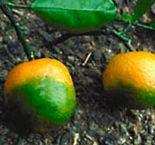
A breakthrough has been made in determining the cause of huanglongbing, or citrus greening, that could pave the way for the creation of treatments to prevent the spread of the devastating citrus disease.
Research carried out at the University of Florida in the US has confirmed that the disease is 'almost certainly' the result of a lone species of bacteria, and not that of a combination of bacterial or viral pathogens as some in the industry had feared.
Following the examination of bark from Florida citrus trees infected with greening, scientists conclusively discovered the genetic fingerprint of the bacteria commonly suspected to be behind the disease, Candidatus Liberibacter asiaticus, with no other DNA present.
The research is important as it circumnavigates traditional methods - growing the bacteria in a petri dish and inserting it into a healthy tree - that have thus far proved unsuccessful.
'This research tells us that our work, much of which has been focused on Liberibacter, is dead on, on target,' said Jacqueline Burns, director of the Citrus Research and Education Center at Lake Alfred. 'It gives us confidence to move on with research that helps target this pathogen.'
As there is currently no cure for citrus greening, which slowly weakens and kills all types of citrus trees while making the fruit malformed and discoloured, the only solution is to destroy infected and potentially infected trees.



